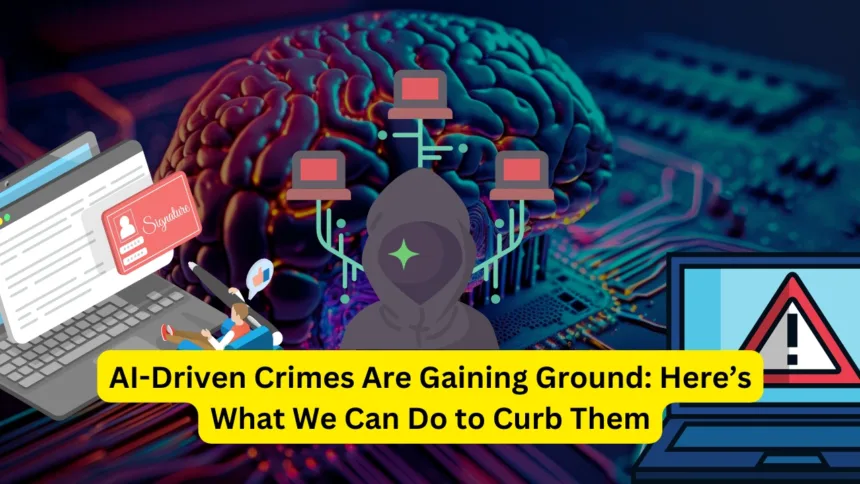Introduction to AI-Driven Crimes
Artificial Intelligence (AI) has revolutionized various sectors, from healthcare to finance. However, as with any powerful tool, it has a darker side. Criminals are increasingly harnessing the power of AI to carry out sophisticated crimes, making it a growing concern globally. But what exactly are AI-driven crimes, and how can we combat them? Let’s dive into the world of AI-fueled criminal activities and explore the solutions we need to implement.
Understanding AI-Driven Crimes
What Are AI-Driven Crimes?
AI-driven crimes refer to criminal activities that leverage artificial intelligence to execute, enhance, or plan illegal actions. Unlike traditional crimes, these activities utilize advanced algorithms and machine learning models to evade detection and maximize impact.
Types of AI-Driven Crimes
Cyberattacks and Hacking
AI is increasingly being used in cyberattacks to automate and scale up hacking attempts. AI-driven malware can adapt and evolve to bypass cybersecurity measures, making them more dangerous than ever.
AI-Enhanced Fraud
Criminals use AI to carry out financial frauds, such as identity theft, by analyzing large datasets to create convincing fake identities. These AI-enhanced frauds are harder to detect and can cause significant financial damage.
Deepfakes and Misinformation
Deepfakes, created using AI, are realistic fake videos or audio recordings that can be used to manipulate public opinion, blackmail individuals, or spread misinformation. The rise of deepfakes poses a significant threat to both personal security and democratic processes.
Autonomous Weapons and Drones
AI-controlled weapons and drones can be used for unlawful activities, such as targeted assassinations or smuggling contraband. These autonomous systems can operate without human intervention, making them difficult to trace and stop.
The Growth of AI-Driven Crimes
Statistics and Trends
The rise of AI-driven crimes is not just a futuristic concern—it’s happening now. According to recent studies, cybercrimes involving AI have increased by over 40% in the past five years. This alarming trend highlights the urgent need for stronger measures to combat this evolving threat.
How AI Is Empowering Criminals
AI provides criminals with tools to automate and scale their operations, making it easier to carry out large-scale attacks with minimal effort. Whether it’s through AI-generated phishing emails or automated cyberattacks, criminals are finding new ways to exploit this technology for nefarious purposes.
Challenges in Combating AI-Driven Crimes
The Complexity of AI Technology
One of the primary challenges in combating AI-driven crimes is the complexity of the technology itself. AI systems are often “black boxes,” meaning it’s difficult to understand how they operate and make decisions. This makes it challenging to detect and counteract AI-driven criminal activities effectively.
Legal and Ethical Issues
The legal framework around AI and its use in criminal activities is still in its infancy. Many jurisdictions lack the necessary laws to address AI-driven crimes, and ethical concerns further complicate the development of regulations.
The Role of Global Collaboration
AI-driven crimes often transcend national borders, making international cooperation essential. However, differing laws, regulations, and priorities among countries can hinder effective collaboration in combating these crimes.
Strategies to Curb AI-Driven Crimes
Strengthening Cybersecurity Measures
To combat AI-driven crimes, organizations must invest in robust cybersecurity measures. This includes deploying AI-based defense systems that can detect and respond to AI-driven attacks in real-time.
Enhancing AI Regulations
Governments and regulatory bodies need to develop and enforce regulations that specifically address AI-driven crimes. This could include guidelines for ethical AI development, mandatory security protocols for AI systems, and penalties for misuse.
Public Awareness and Education
Raising public awareness about AI-driven crimes is crucial. Educating individuals on how to recognize and protect themselves from these threats can help reduce the risk of falling victim to AI-enhanced scams and attacks.
Promoting Ethical AI Development
Encouraging the development of ethical AI practices can help prevent the misuse of this technology. This involves creating AI systems with built-in safeguards to prevent them from being repurposed for criminal activities.
International Cooperation and Policy Making
Countries must work together to create a unified approach to combating AI-driven crimes. This includes sharing intelligence, harmonizing regulations, and collaborating on research and development of countermeasures.
Future of AI and Crime
Potential Risks and Opportunities
As AI technology continues to evolve, so too will the methods used by criminals. However, with the right strategies in place, AI can also be a powerful tool in the fight against crime. The key lies in staying ahead of the curve by anticipating potential threats and developing proactive solutions.
The Importance of Ongoing Vigilance
Combating AI-driven crimes requires continuous vigilance. As criminals adapt to new technologies, so too must our defenses. This means regularly updating cybersecurity protocols, staying informed about emerging threats, and fostering a culture of awareness and preparedness.
Conclusion
AI-driven crimes are a growing threat that demands immediate attention. While the challenges are significant, they are not insurmountable. By strengthening cybersecurity measures, enhancing regulations, and promoting ethical AI development, we can curb the rise of AI-driven criminal activities. It’s a collective effort that requires the cooperation of governments, organizations, and individuals alike.
FAQs
What are AI-driven crimes?
AI-driven crimes involve the use of artificial intelligence to execute, enhance, or plan illegal activities, such as cyberattacks, fraud, and the creation of deepfakes.
How can AI be used for criminal activities?
AI can be used to automate and scale cyberattacks, create realistic deepfakes, enhance fraud schemes, and even control autonomous weapons for unlawful purposes.
What are the main challenges in combating AI-driven crimes?
The complexity of AI technology, lack of legal frameworks, ethical concerns, and the need for international collaboration are the main challenges in combating AI-driven crimes.
How can individuals protect themselves from AI-driven crimes?
Individuals can protect themselves by staying informed about AI-driven threats, using robust cybersecurity measures, and being cautious about sharing personal information online.
What is the future outlook on AI-driven crimes?
AI-driven crimes are likely to become more sophisticated over time, but with ongoing vigilance and proactive measures, we can mitigate their impact and protect society.









